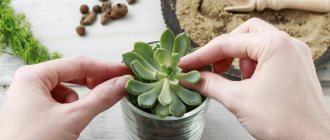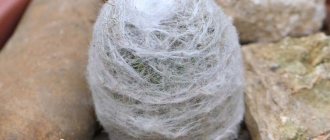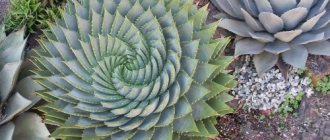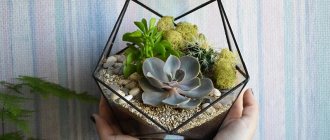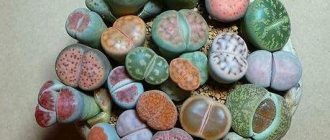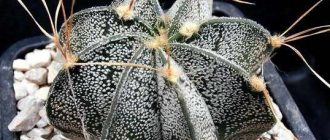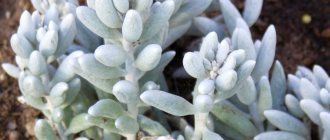Soil selection criteria
Many novice gardeners buy succulents at the store without knowing how to grow them. After purchasing, it is important to know not only how to replant a purchased succulent at home, but also what soil to use for this.
Succulents
To grow succulents, you should choose loose soil that allows air and water to pass through well. Succulents grow both in soil with neutral acidity and in acidic soil. The soil should not contain a lot of nitrogenous fertilizers; it should contain enough mineral components.
What kind of land is needed for planting succulents can be determined by the requirements determined by the preferences of the plants:
- It should be light and loose. Water should pass through it quickly.
- The soil particles must provide air flow to the roots.
- The top layer should dry quickly.
When buying soil in a store, you need to pay attention to its composition. Depending on the type of succulents for planting, soil requirements differ.
The bulk of purchased soil is peat. Most often, two types of it are mixed: upland and lowland. Peat has high acidity, so dolomite flour is added to the soil to reduce it.
Top layer design
Before planting the succulent in a container, the top layer of soil is covered with drainage. It is acceptable to cover the ground with the same material that lined the bottom of the container, but experts recommend choosing a different component.
If you want to use stone, choose larger pieces.
Be sure to remove the top layer before watering, otherwise the plant may rot at the point of contact with the soil.
DIY soil for succulents
Gatsania flower - how it blooms on a club, what soil is needed for growing
You can prepare the soil for growing succulents in pots with your own hands from ordinary universal purchased soil. To make it lighter, coarse sand, ceramic fragments and expanded clay should be added to it. To increase the acidity of the soil, peat is added to it.
Soil for succulents
Experienced flower growers recommend both buying a ready-made mixture for growing succulents and preparing the soil yourself. The main thing is to use the right ingredients and maintain their proportions.
Required Components
The soil for succulents can be prepared entirely with your own hands. The main components of soil for cacti and succulents are:
- leaf soil,
- turf land,
- sand,
- pebbles or crumbs of red bricks.
You can use gravel as soil for succulents. Depending on the size of the flowerpot, 3 types of pebbles are used:
- fraction 1-5 mm;
- fraction 5-10 mm;
- fraction 10-30 mm.
Interesting. Barsik non-clumping cat litter can be used as soil for succulents. It consists of a fine fraction of zeolite. It should be added to gravel in a ratio of 1 to 10.
Substrate proportion
Depending on the root system of the plant, the proportions of the constituent components also change. If the root system is represented by superficial roots, then it is necessary to achieve increased lightness from the soil. The main components are mixed in the following proportions:
- 1 measuring cup of leaf soil;
- 1 measuring cup turf soil;
- 1 measuring cup of sand;
- ½ cup of sand or crumbs.
For plants with well-developed, fleshy roots capable of storing water, the ratios will be different. You only need 3 components: 1 part sand and leaf soil, 1.5 parts turf soil.
Important! When preparing to replant any type of cactus or succulent in a pot, you need to make a thick drainage layer. This will protect the roots from rotting.
When planting plants in a pot, you need to lay 3 layers:
- Drainage. Must be at least 1 cm.
- The main layer is made from purchased soil or homemade soil. This soil layer should not reach the top of the pot by 2 cm.
- Top layer of drainage. Pebbles, brick chips or expanded clay are used for it.
Layer arrangement in a flowerpot
Important! Before watering, the top layer is removed. It must always be dry.
Useful tips
- Let's not forget that in reality the soil on which succulents grow is very poor. There is always a shortage of water and nutrients, so the soil should be prepared so that it does not retain liquid, and only a little peat (or humus) should be added so that the plant can take root.
- No organic materials should be added to the soil mixture, only leaf humus. These exotic plants do not tolerate nitrogen, which is actively produced upon contact with organic matter.
- The soil must be disinfected in accordance with certain rules. Sand and soil should be heated in the oven for at least 1-2 hours. You can also heat it in a frying pan with a lid.
- Stones, brick fragments and other drainage materials are washed with water, then cleaned in a solution of potassium permanganate and dried on a cloth or in an oven.
- Succulents require special soil for planting, but all the effort spent on preparation pays off handsomely. If the soil is prepared correctly, the plant will not get sick, will grow faster and delight everyone around with its unusual beauty. A careful and thoughtful approach will save the grower a lot of time when caring for the plant in the future.
Interesting article: The best flowers in pots on March 8
Options for growing succulents
Fans of desert plants often want to breed new species. But it is rare that you can purchase a cutting or part of a plant for propagation. Therefore, lovers of exotic plants are faced with the question: “How to plant succulents?”
Vegetative propagation
Cymbidium orchid: options for growing and caring at home
You can grow succulents either from seeds or plant parts. Many types of succulents produce daughter plants on stems. This most often occurs in cacti. You can remove such a plant from the mother plant only after it is fully formed. The signal for this is the gradual detachment of the bottom of the new plant from the mother’s stem.
Other types of succulents are propagated from cuttings or leaves. These parts of the plant can be planted almost immediately into succulent soil.
Important! It is not advisable to root cuttings and leaves in water. This can lead to their rotting.
Many plants in hot and dry countries shed their leaves to reproduce. One such species is Crassula. If a fallen leaf is left on the soil, after a few weeks it will take root and a new plant will begin to develop.
It is better to plant succulents from cuttings in the spring. At this time, they take root well and will get stronger over the summer.
From seeds
Exotic species can only be grown from seeds. You can buy them either in a regular flower shop or order them from an online store.
You can grow succulents from seeds either by following the recommendations of gardeners or by taking into account some of the peculiarities of the propagation of cacti and succulents.
You can germinate seeds using a special container with a transparent lid. You can buy such a container in a store.
Important! There should be small boxes inside the container for planting. Be sure to make drainage holes in the bottom of the pots.
It is best to germinate succulent seeds in a mineral base: a mixture of gravel, sand and perlite. Seeds of plants such as aloe or gasteria are best sown in perlite.
After distributing the substrate among the pots, take a thick sheet of paper and fold it in half. Seeds are poured into the resulting fold and, lightly tapping the folds, they are evenly distributed over the surface of the soil.
When all the seeds are distributed over the surface, they are sprinkled with a layer of sand no more than 2 mm. In this way, you can plant succulents with both large and small seeds.
Important! The covering layer should not exceed the size of the seeds. Very small seeds are not sprinkled at all.
The crops are watered with settled water at room temperature. In order not to wash away the seeds, they need to be watered by spraying from a spray bottle. After watering, cover the container with a transparent lid or film.
The greenhouse begins to be removed after the emergence of seedlings. The hardening time is gradually increased and the cover is removed after the plants reach a size of 2 cm.
Sprouted seeds
When growing succulents from seeds, be patient. Each species has different germination times. Some seeds germinate in 90 days. All this time the soil must be kept moist.
New seedlings can be planted after the seedlings have become stronger and are at least 5 cm in height. Some species require several months for this, while others take a year.
Characteristics and use of hydrogel
Hydrogel has recently appeared in flower shops. This product immediately attracted the attention of buyers due to its amazing appearance. It may be sold in granule, powder, or crystal form.
It is able to absorb and retain moisture. When elements get wet, they increase significantly in size. Manufacturers add safe dyes to the recipe, thanks to which the granules shimmer in different colors.
Larger hydrogels are used as substrate and soil substitutes for indoor plants. Plants are planted in transparent containers, creating amazing living compositions.
The fine product is mixed with the soil. It is often used to germinate seeds.
The product often acts as a decorative addition to the interior. Mix a few bright colors in a clear container to make your decoration colorful and expressive.
This element becomes an accent and completes the style.
Hydrogel and succulents
Many people wonder if hydrogel can be used to grow succulents. Experienced experts say that this product is not suitable for plants in this category.
The main function of hydrogel is to retain moisture, and succulents do this very well on their own. It is also not recommended to plant succulents in soil mixed with fine hydrogel.
Home care
Mimosa flower: growing conditions and plant care options
When growing succulents, you should distinguish between winter and summer care. In the warm season, plants should be watered no more than twice a week. At this time, the plant is actively growing, so regular feeding is needed. In winter, watering is reduced to twice a month, and fertilizing should be stopped completely.
Important! Succulents and cacti cannot grow well without sunlight. They are not afraid of direct sunlight, so they can be safely placed on the windowsill.
In winter, for more light, it is better to place pots with succulents close to the glass. This will help lower the temperature by 2-3 C and increase the lighting of the plant.
Succulents can be replanted in both spring and summer. Inspecting the succulents will help determine the need for replanting. The following signs will indicate the need for this procedure:
- A gap has formed between the pot and the soil.
- Roots emerged from the drainage holes.
- The size of the plant exceeds the volume of the flowerpot.
Both professionals and beginners can replant succulents at home. The transplant must be carried out following the following steps:
- To transplant succulents and cacti, prepare a pot, soil, drainage and hand protection. In addition to gloves, it can be foam or thick cardboard.
- About a week before transplanting, stop watering the plant.
- If the succulent is healthy, then it can be transplanted using the transshipment method. If it is necessary to inspect the roots, carefully remove the dried soil.
- The plant is placed in a new pot and covered with substrate. After watering, the top layer is covered with pebbles or expanded clay.
To provide exotic species of succulents with an optimal microclimate, they can be planted in special florariums. These are special glass or transparent plastic vessels with a narrow neck. Often it is closed with a stopper. Quite often they are equipped with a heating and lighting system.
Florarium
When creating a succulent composition, you need to choose plants from the same area. They should have similar watering regimes and lighting needs. If you do not take this rule into account, the plants will quickly die.
The right approach and adherence to the rules of care will help you grow not only familiar plants at home, but also surprise your guests with plants from other countries. By combining succulents of different shapes and colors, you can create a beautiful composition that will decorate your home.
How to use coconut substrate?
Few people know how to properly use this product and plant plants in it. If you choose a substrate in the form of briquettes, they must first be soaked. This is done simply: the material is placed in a deep container and filled with warm or hot water. During the work, as it is absorbed, the liquid is gradually added.
The substrate will begin to increase in size and fall apart. A briquette weighing 1 kilogram will yield about 6 kilograms of soil, ready for planting. Some experts advise rinsing the product with high-temperature running water after swelling. To do this, the substrate is covered with gauze; nylon products can also be used.
The moistened substrate is sent to a container with drainage lined at the bottom, after which the plant is planted in it. Then the mixture needs to be fertilized. Compositions containing nitrogen are best suited for this. They also use special complex formulations intended for plants of various varieties.
